清华大学经济学原理(钱颖一)Chapter_26
经济学原理第1章

五、市场经济对生产的组织
2、价格
价格是商品同货币交换比例的指数,或者说,价格是价值的 货币表现。价格是商品的交换价值在流通过程中所取得的转 化形式。在经济学及营商的过程中,价格是一项以货币为表 现形式,为商品、服务及资产所订立的价值数字。在微观经 济学之中,资源在需求和供应者之间重新分配的过程中,价 格是重要的变数之一。
生产可能性边界 ❖ 假设全社会的全部资源用于生产A、B两种商
品,由于资源的有限性,我们生产的商品不可 能无限多。现有如下几种可能:
ⅠⅡ Ⅲ Ⅳ Ⅴ ❖ A 10 9 7 4 0 ❖B 0 1 2 3 4
A
D E C
B
❖ 在这一曲线上的任一点都是在既定资源 条件下生产A、B两种产品的最大可能。
❖ 生产可能性边界又称生产可能曲线,指 社会使用既定的生产资源所能生产商品 的最大组合。
五、市场经济对生产的组织
❖ 市场是商品交换顺利进行的条件,是商品流 通领域一切商品交换活动的总和。市场体系 是由各类专业市场,如商品服务市场、金融 市场、劳务市场、技术市场、信息市场、房 地产市场、文化市场、旅游市场等组成的完 整体系。同时,在市场体系中的各专业市场 均有其特殊功能,它们互相依存、相互制约, 共同作用于社会经济。
经济一词来源于希腊语,意思是“管理家庭的人” 经济的定义(内涵):如何以最小的代价取得最大的收益。
❖ 经邦济世、经才济世
一个家庭和经济体面临很多决策:
v 谁去工作? v 应该生产什么物品?应该生产多少? v 应该用什么资源生产? v 物品的销售价格应该是多少?Βιβλιοθήκη Economics 经济学
经济学——研究社会如何管理自己的稀
生产可能性边界
生产可能性边界 向外移动
钱颖一“理解现代经济学”

现代经济学在发展
• 现代经济学理论的假定在修改
--信息经济学 信息经济学(information economics) 信息经济学 不对称信息对市场运行的影响 --行为经济学 --行为经济学(behavioral economics) 行为经济学(behavioral
现代经济学中数学的作用
为什么经济学不是数学 经济想法最重要, 经济想法最重要,数学是工具
• 不能以数学水平的高低来衡量经济学家的水平 • 不能以运用数学的多少和难易程度来评判经济学论文质量
经济学是社会科学,理论必须接受现实检验 经济学是社会科学,
• 经济学理论最终都要接受现实的检验 • 新的理论的创立和旧的理论的发展要受现实的启发
现代经济学的分析框架
• 理论分析框架的三个主要部分 (3)分析工具 )分析工具(analytical tool)
• 例1: 供需曲线图象模型 • 例2: Samuelson: 重叠代模型 重叠代模型(overlapping generation model) • 例3: Grossman-Hart-Moore: 所有权 控制权模型 所有权-控制权模型 (control rights model) • 例4: Laffont-Tirole: 非对称信息模型 非对称信息模型(asymmetric information model) • 例5: Diamond-Dybvig: 银行挤兑模型 银行挤兑模型(bank-run model)
– 分析框架的三个主要部分都相关
• 视角 • 参照系 • 分析工具
用现代经济学分析中国的改革
经济学原理电子书
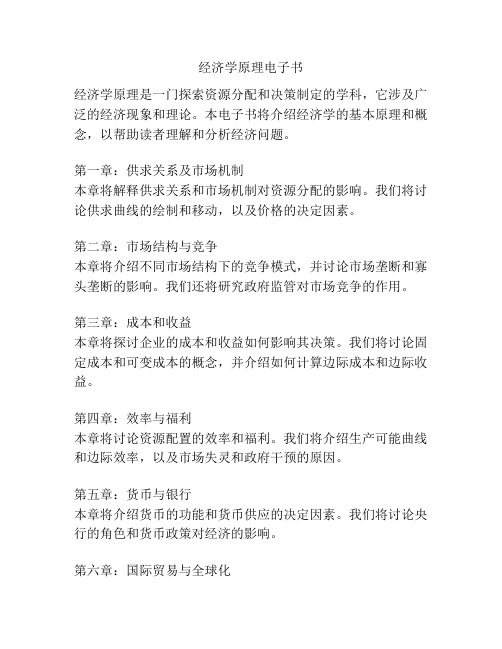
经济学原理电子书经济学原理是一门探索资源分配和决策制定的学科,它涉及广泛的经济现象和理论。
本电子书将介绍经济学的基本原理和概念,以帮助读者理解和分析经济问题。
第一章:供求关系及市场机制本章将解释供求关系和市场机制对资源分配的影响。
我们将讨论供求曲线的绘制和移动,以及价格的决定因素。
第二章:市场结构与竞争本章将介绍不同市场结构下的竞争模式,并讨论市场垄断和寡头垄断的影响。
我们还将研究政府监管对市场竞争的作用。
第三章:成本和收益本章将探讨企业的成本和收益如何影响其决策。
我们将讨论固定成本和可变成本的概念,并介绍如何计算边际成本和边际收益。
第四章:效率与福利本章将讨论资源配置的效率和福利。
我们将介绍生产可能曲线和边际效率,以及市场失灵和政府干预的原因。
第五章:货币与银行本章将介绍货币的功能和货币供应的决定因素。
我们将讨论央行的角色和货币政策对经济的影响。
第六章:国际贸易与全球化本章将探讨国际贸易的原理和全球化的影响。
我们将讨论比较优势理论和贸易保护主义的争议。
第七章:失业与通胀本章将介绍失业和通胀的原因和影响。
我们将讨论劳动市场的均衡和通货膨胀与货币供应的关系。
第八章:经济增长与发展本章将探讨经济增长和发展的原因和影响。
我们将研究经济增长模型和不同国家发展水平的差异。
第九章:税收与财政政策本章讨论税收的原理和财政政策的作用。
我们将介绍不同类型的税收和它们对经济的影响,以及政府支出的决策。
第十章:市场外部性与公共物品本章将介绍市场外部性和公共物品的特征及其对资源配置的影响。
我们将讨论外部性的纠正措施和公共物品的供应方式。
总结本电子书通过介绍经济学的基本原理和概念,帮助读者理解经济现象和问题。
我们希望读者能够运用这些知识,更好地分析和解决经济和社会的挑战。
经济学原理清华大学学堂在线答案

经济学原理清华大学学堂在线答案
1.消费者理性偏好原理:消费者在有限的收入下,会根据他们的偏好,尽可能多的消费他们喜欢的商品,使其总收入得到最大化。
2.最优产出原理:无论企业所面临的情况有多复杂,企业都会选择使
总产出最大化的那种技术,以获取最大的经济利益。
3.均衡价格原理:对于绝大部分市场结构,当供给量与需求量达到相
同的时候,市场价格就会达到均衡价格。
4.货币价值原理:货币价值的影响因素包括物价的涨落,货币的流通
遍布,国家的经济稳定程度,以及政府的价格管制等。
5.拉斯维加斯原理:拉斯维加斯原理是指在一个多变的经济环境中,
投资者的所有权变换与其本身拥有资产的程度是不成比例的,而其他因素
也有很大影响。
6.投资价格原理:投资者在选择投资时,对风险和收益都会进行权衡,最终他们的投资会侧重于那些产生相对较低风险但有足够回报的投资项目。
7.产出不平衡原理:有时企业会有一定的资源分配不均衡的问题,在
这种情况下,企业会偏好把他们的资源分配到比较有效率的商品上,以获
取最大的产出,而忽视那些比较无效率的商品。
8.总体供给原理:总体供给由供给因素的供给与变动有关。
钱颖一:教育决定中国经济未来
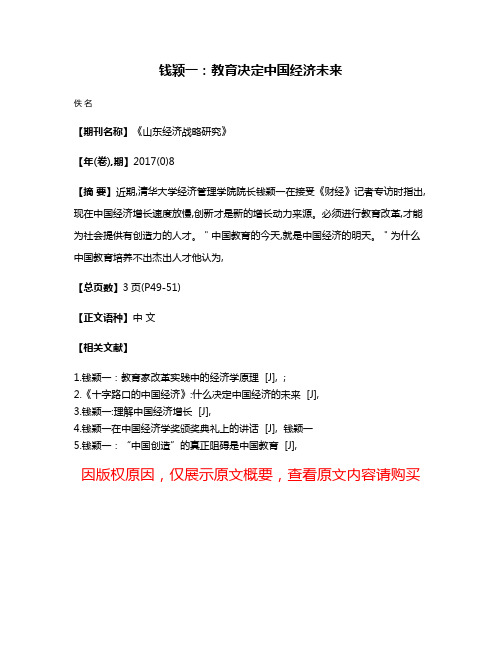
钱颖一:教育决定中国经济未来
佚名
【期刊名称】《山东经济战略研究》
【年(卷),期】2017(0)8
【摘要】近期,清华大学经济管理学院院长钱颖一在接受《财经》记者专访时指出,现在中国经济增长速度放慢,创新才是新的增长动力来源。
必须进行教育改革,才能为社会提供有创造力的人才。
"中国教育的今天,就是中国经济的明天。
"为什么中国教育培养不出杰出人才他认为,
【总页数】3页(P49-51)
【正文语种】中文
【相关文献】
1.钱颖一:教育家改革实践中的经济学原理 [J], ;
2.《十字路口的中国经济》:什么决定中国经济的未来 [J],
3.钱颖一:理解中国经济增长 [J],
4.钱颖一在中国经济学奖颁奖典礼上的讲话 [J], 钱颖一
5.钱颖一:“中国创造”的真正阻碍是中国教育 [J],
因版权原因,仅展示原文概要,查看原文内容请购买。
钱颖一:经济学科在美国-精选.doc
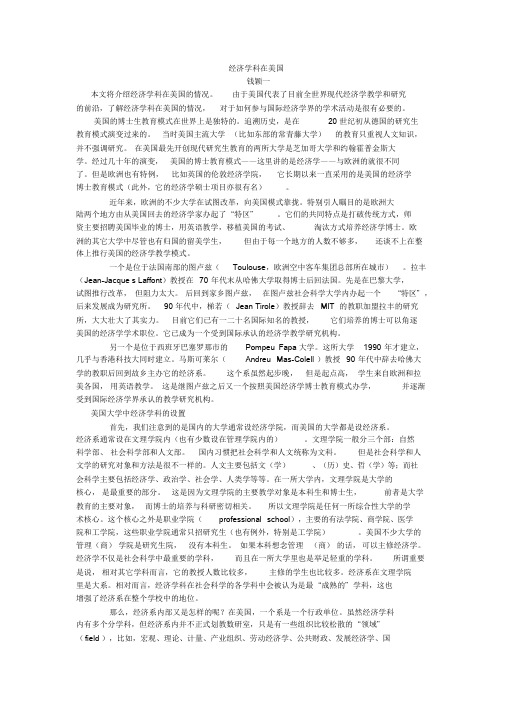
经济学科在美国钱颖一本文将介绍经济学科在美国的情况。
由于美国代表了目前全世界现代经济学教学和研究的前沿,了解经济学科在美国的情况,对于如何参与国际经济学界的学术活动是很有必要的。
美国的博士生教育模式在世界上是独特的。
追溯历史,是在20 世纪初从德国的研究生教育模式演变过来的。
当时美国主流大学(比如东部的常青藤大学)的教育只重视人文知识,并不强调研究。
在美国最先开创现代研究生教育的两所大学是芝加哥大学和约翰霍普金斯大学。
经过几十年的演变,美国的博士教育模式——这里讲的是经济学——与欧洲的就很不同了。
但是欧洲也有特例,比如英国的伦敦经济学院,它长期以来一直采用的是美国的经济学博士教育模式(此外,它的经济学硕士项目亦很有名)。
近年来,欧洲的不少大学在试图改革,向美国模式靠拢。
特别引人瞩目的是欧洲大陆两个地方由从美国回去的经济学家办起了“特区”。
它们的共同特点是打破传统方式,师资主要招聘美国毕业的博士,用英语教学,移植美国的考试、淘汰方式培养经济学博士。
欧洲的其它大学中尽管也有归国的留美学生,但由于每一个地方的人数不够多,还谈不上在整体上推行美国的经济学教学模式。
一个是位于法国南部的图卢兹(Toulouse,欧洲空中客车集团总部所在城市)。
拉丰(Jean-Jacque s Laffont)教授在70 年代末从哈佛大学取得博士后回法国。
先是在巴黎大学,试图推行改革,但阻力太大。
后回到家乡图卢兹,在图卢兹社会科学大学内办起一个“特区”,后来发展成为研究所。
90 年代中,梯若(Jean Tirole)教授辞去MIT 的教职加盟拉丰的研究所,大大壮大了其实力。
目前它们已有一二十名国际知名的教授,它们培养的博士可以角逐美国的经济学学术职位。
它已成为一个受到国际承认的经济学教学研究机构。
另一个是位于西班牙巴塞罗那市的Pompeu Fapa 大学。
这所大学1990 年才建立,几乎与香港科技大同时建立。
马斯可莱尔(Andreu Mas-Colell )教授90 年代中辞去哈佛大学的教职后回到故乡主办它的经济系。
走向好的市场经济
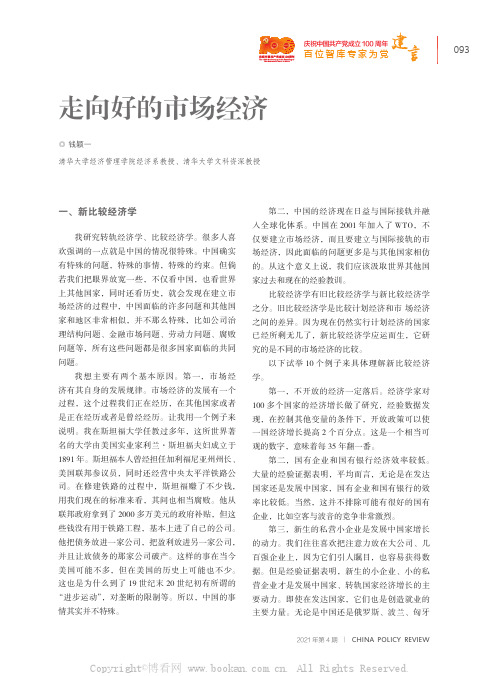
百位智库专家为党走向好的市场经济◎ 钱颖一清华大学经济管理学院经济系教授、清华大学文科资深教授一、新比较经济学我研究转轨经济学、比较经济学。
很多人喜欢强调的一点就是中国的情况很特殊。
中国确实有特殊的问题,特殊的事情,特殊的约束。
但倘若我们把眼界放宽一些,不仅看中国,也看世界上其他国家,同时还看历史,就会发现在建立市场经济的过程中,中国面临的许多问题和其他国家和地区非常相似,并不那么特殊,比如公司治理结构问题、金融市场问题、劳动力问题、腐败问题等,所有这些问题都是很多国家面临的共同问题。
我想主要有两个基本原因。
第一,市场经济有其自身的发展规律。
市场经济的发展有一个过程,这个过程我们正在经历,在其他国家或者是正在经历或者是曾经经历。
让我用一个例子来说明。
我在斯坦福大学任教过多年,这所世界著名的大学由美国实业家利兰·斯坦福夫妇成立于1891年。
斯坦福本人曾经担任加利福尼亚州州长、美国联邦参议员,同时还经营中央太平洋铁路公司。
在修建铁路的过程中,斯坦福赚了不少钱,用我们现在的标准来看,其间也相当腐败。
他从联邦政府拿到了2000多万美元的政府补贴,但这些钱没有用于铁路工程,基本上进了自己的公司。
他把债务放进一家公司,把盈利放进另一家公司,并且让放债务的那家公司破产。
这样的事在当今美国可能不多,但在美国的历史上可能也不少。
这也是为什么到了19世纪末20世纪初有所谓的“进步运动”,对垄断的限制等。
所以,中国的事情其实并不特殊。
第二,中国的经济现在日益与国际接轨并融入全球化体系。
中国在2001年加入了WTO,不仅要建立市场经济,而且要建立与国际接轨的市场经济,因此面临的问题更多是与其他国家相仿的。
从这个意义上说,我们应该汲取世界其他国家过去和现在的经验教训。
比较经济学有旧比较经济学与新比较经济学之分。
旧比较经济学是比较计划经济和市 场经济之间的差异。
因为现在仍然实行计划经济的国家已经所剩无几了,新比较经济学应运而生,它研究的是不同的市场经济的比较。
钱颖一:理解现代经济学
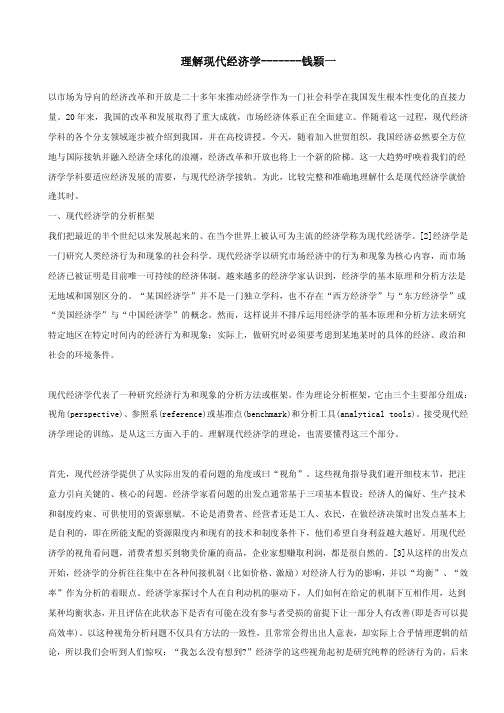
理解现代经济学-------钱颖一以市场为导向的经济改革和开放是二十多年来推动经济学作为一门社会科学在我国发生根本性变化的直接力量。
20年来,我国的改革和发展取得了重大成就,市场经济体系正在全面建立。
伴随着这一过程,现代经济学科的各个分支领域逐步被介绍到我国,并在高校讲授。
今天,随着加入世贸组织,我国经济必然要全方位地与国际接轨并融入经济全球化的浪潮,经济改革和开放也将上一个新的阶梯。
这一大趋势呼唤着我们的经济学学科要适应经济发展的需要,与现代经济学接轨。
为此,比较完整和准确地理解什么是现代经济学就恰逢其时。
一、现代经济学的分析框架我们把最近的半个世纪以来发展起来的、在当今世界上被认可为主流的经济学称为现代经济学。
[2]经济学是一门研究人类经济行为和现象的社会科学。
现代经济学以研究市场经济中的行为和现象为核心内容,而市场经济已被证明是目前唯一可持续的经济体制。
越来越多的经济学家认识到,经济学的基本原理和分析方法是无地域和国别区分的。
“某国经济学”并不是一门独立学科,也不存在“西方经济学”与“东方经济学”或“美国经济学”与“中国经济学”的概念。
然而,这样说并不排斥运用经济学的基本原理和分析方法来研究特定地区在特定时间内的经济行为和现象;实际上,做研究时必须要考虑到某地某时的具体的经济、政治和社会的环境条件。
现代经济学代表了一种研究经济行为和现象的分析方法或框架。
作为理论分析框架,它由三个主要部分组成:视角(perspective)、参照系(reference)或基准点(benchmark)和分析工具(analytical tools)。
接受现代经济学理论的训练,是从这三方面入手的。
理解现代经济学的理论,也需要懂得这三个部分。
首先,现代经济学提供了从实际出发的看问题的角度或曰“视角”。
这些视角指导我们避开细枝末节,把注意力引向关键的、核心的问题。
经济学家看问题的出发点通常基于三项基本假设:经济人的偏好、生产技术和制度约束、可供使用的资源禀赋。
钱颖一_经济学科在美国

《经济社会体制比较》2001年第6期经济学科在美国钱颖一1编者按:不久前本刊编委钱颖一教授在北京大学经济学院作了题为“经济学科在美国”的报告。
钱颖一于1981年从清华大学毕业后赴美留学,分别获得哥伦比亚大学统计学硕士、耶鲁大学运筹管理科学硕士和哈佛大学经济学博士学位。
1990年开始工作,先后在斯坦福大学经济系、马里兰大学经济系和伯克利加州大学经济系任教。
以他这样的经历作出的演讲,对于许多希望了解美国经济学科情况的读者,肯定是非常有意思的信息。
我们将他的报告整理稿经作者本人修改后,刊于本期,以飨读者。
本文将介绍经济学科在美国的情况。
由于美国代表了目前全世界现代经济学教学和研究的前沿,了解经济学科在美国的情况,对于如何参与国际经济学界的学术活动是很有必要的。
我介绍以下四个方面的情况:第一,美国大学中经济学科的设置;第二,美国大学的经济学教育;第三,美国的经济学博士教育模式在欧洲;第四,中国学生申请留学美国攻读经济学学位时应注意的事项。
一、美国大学中经济学科的设置首先,我们注意到的是国内的大学通常设经济学院,而美国的大学都是设经济系。
经济系通常设在文理学院内(也有少数设在管理学院内的)。
文理学院一般分三个部:自然科学部、社会科学部和人文部。
国内习惯把社会科学和人文统称为文科。
但是社会科学和人文学的研究对象和方法是很不一样的。
人文主要包括文(学)、(历)史、哲(学)等;而社会科学主要包括经济学、政治学、社会学、人类学等等。
在一所大学内,文理学院是大学的核心,是最重要的部分。
这是因为文理学院的主要教学对象是本科生和博士生,前者是大学教育的主要对象,而博士的培养与科研密切相关。
所以文理学院是任何一所综合性大学的学术核心。
这个核心之外是职业学院(professional school),主要的有法学院、商学院、医学院和工学院,这些职业学院通常只招研究生(也有例外,特别是工学院)。
美国不少大学的管理(商)学院是研究生院,没有本科生。
钱颖一经济学原理

经济学在各门学科中的位置
自然科学 数理化生 社会科学 经政社心 人文 文史哲
它的主题是社会的——人们的选择如何引导他们的生 活,以及他们如何相互影响。 Its subject matter is society – how people choose to lead their lives and how they interact with one another. 但它以科学的冷静来研究这个主题。 It approaches its subject with the dispassion of a science.
3
工
建筑
医
商
公共 管理
法
新闻 传播 美术
4
Fields in Economics 经济学的学科领域
金融学是经济学科的一部分
什么是金融学(Finance)
“微观金融”(finance)
公司金融(corporate 资产定价(asset
微观经济学Micro 宏观经济学Macro 计量经济学 Econometrics 金融学Finance 产业组织Industrial Organization 劳动经济学Labor 公共财政Public Finance
22
经济学的十个原理
人们如何相互作用 How People Interact
5. 贸易能使人人收益。 Trade can make everyone better off. 6. 市场通常是组织经济活动的好方式。 Markets are usually a good way to organize economic activity. 7. 政府有时可以改进市场结果。 Governments can sometimes improve market outcomes.
钱颖一:理解经济学原理

钱颖⼀:理解经济学原理作者:钱颖⼀经济学家,清华⼤学⽂科资深教授,曾任清华⼤学经济管理学院院长全⽂15230字,预计阅读需30分钟。
经济学原理为什么重要?钱颖⼀说:经济学原理是经济学家之间的最⼤共识,它是⽤最简单的逻辑来解释复杂的经济现象,它追本溯源,探求最根本的因。
他在清华⼤学只开⼀门课,就是《经济学原理》。
⼀、为什么经济学原理重要?14年前的2002年,我受聘为清华⼤学经济管理学院特聘教授。
当时不只我⼀个⼈,⽽是⼀共有15位在海外⼤学任教的经济学教授受聘为特聘教授,每⼈在清华经管学院开设⼀门课程。
绝⼤部分特聘教授开的是博⼠⽣课程,⽽我⾃告奋勇开设本科⼀年级两个学期的《经济学原理》。
2002年9⽉我在清华第⼀次上这门课时的情景,⾄今历历在⽬。
那是在清华⼤学的主楼后厅,⼤概有500个座位。
也许是因为第⼀次开这样的课,所以吸引了很多学⽣,除了清华经管学院2002级和2001级本科⽣外,也有清华其他院系和清华外的同学来听课。
在过去的14年间,我⼀直坚持在清华经管学院开这门课,是同另外⼀位教师⼀起开。
在2004—2005学年和2005—2006学年,我还同时在北京⼤学经济学院开设了这门课。
现在北京⼤学经济学院也⼀直在开这门课。
在我开设这门课之前,两个学期的《经济学原理》在中国的⼤学中或者不存在,或者只是⼀个学期的《经济学基础》。
中国学⽣更重视《中级微观经济学》和《中级宏观经济学》,因为通常认为中国学⽣的数学基础⽐较好,可以直接学习中级经济学,⽽《经济学原理》不⽤数学,太浅,不需要教。
2002年秋季在清华开这门课的时候,我坚持⼀定要两个学期。
现在回过头来想,这是做对了的⼀件事。
尽管我本⼈在清华本科念的是数学专业,数学对于我学习经济学很有帮助,但是我强烈地感觉到,即使在今天,在国内⼤学⽣和研究⽣的经济学整体⽔平提⾼得很快的情况下,《经济学原理》仍是不可或缺的⼀门课。
这门课看上去简单,没有⽤任何数学,但它是经济学中最重要的基础,因为它传授基本概念、分析思路,特别是培养学⽣的经济学直觉。
清华经济学原理课件

宏观经济学
3. 经济周期
研究经济活动的波动规律,以及如何制定政策来应对经济衰退和繁荣期。
4. 货币供应与货币政策
探讨货币供应与经济增长、通货膨胀之间的关系,以及如何制定货币政策来调控经济运行 。
方法论
宏观经济学采用宏观经济模型,如国民收入恒等式、菲利普斯曲线等,来预测经济走势并 制定相应的政策。此外,它还使用计量经济学方法来检验宏观经济假说和政策效果。
通货膨胀定义及影响
通货膨胀是指商品和服务的总体价格水平上升。通货膨胀会导致实际购买力下降、财富重新分配、产出和就业减 少以及社会总福利降低。
经济增长与可持续发展
经济增长定义及衡量
经济增长是指一个国家或地区的总体产出或总体财富的增长。经济增长通常用国 内生产总值(GDP)来衡量。
可持续发展的概念及目标
01
指导经济发展
经济学的研究成果对国家经济发展和政策制定具有重要的指导作用,有
助于提高国民经济发展水平和人民生活水平。
02 03
促进社会进步
经济学的研究成果有助于解决社会问题,促进社会公正和进步。例如, 经济学对贫困和不平等问题的研究为政府制定相关政策和措施提供了理 论支持。
提高人民生活质量
经济学的研究成果有助于提高人民的生活质量,例如,通过研究消费者 行为和市场均衡,为消费者提供更好的产品和服务;通过研究资源分配 和利用,提高生产效率和资源利用效率。
动态性
经济学随时间和地域的变化而不断发 展,不断探索新的经济问题和现象。
01
02
特点
经济学作为一门社会科学,具有以下 特点
03
综合性
经济学综合了社会科学和自然科学的 多种理论和方法,以全面地解释经济 现象和问题。
理解经济学原理钱颖一读后感300字

理解经济学原理钱颖一读后感300字
《理解经济学原理》是钱颖一教授编写的一本经济学入门教材。
通过阅读这本书,我深刻理解了经济学的基本原理和概念,对经济学的学科体系和思维方式有了更清晰的认识。
书中首先介绍了经济学的基本定义和对象,强调经济学是研究资源配置和决策的科学。
随后,钱教授详细解释了供求关系和市场机制的作用,以及生产要素的决定和收益的分配。
这些内容使我更加了解市场经济运作的原理,明白了市场调节和均衡的重要性。
在经济学原理的学习中,钱教授还强调了边际分析的重要性。
边际分析指的是在决策过程中考虑额外单位的效用或成本变化。
通过边际分析,我们可以更好地理解决策者在做出选择时的权衡和取舍,以及对于资源的最有效利用。
这个概念非常有启发性,让我明白了经济学研究中的一种常见思维方式。
此外,书中还介绍了市场失灵和政府干预的原理。
市场失灵是指市场机制无法实现资源的有效配置,而政府干预则是为了修正市场失灵。
钱教授通过具体案例和理论分析,解释了政府在经济中的重要作用。
这部分内容让我认识到市场和政府在经济运行中的相互作用,以及政府如何通过政策来调整市场。
总的来说,通过阅读《理解经济学原理》,我对经济学的基本原理有
了更深入的理解。
这本书系统地介绍了经济学的核心概念和基本方法,让我对经济学的学科体系和思维方式有了更清晰的认识。
我相信,这对我今后的学习和工作都将有很大的帮助。
经济学原理 电子书

经济学原理电子书引言经济学是研究人类如何分配资源的学科。
它探讨了人们如何做出决策,以及这些决策如何影响经济系统的各个方面。
经济学原理是理解经济学这一学科的基础。
本电子书将介绍经济学原理的核心概念和方法,帮助读者建立起对经济学的基本了解。
第一章:供给和需求供给和需求是经济学中最基本的概念之一。
供给指的是市场中出售的商品或服务的数量,而需求是指消费者愿意购买的商品或服务的数量。
本章将介绍供给和需求的决定因素,以及它们对市场价格和数量的影响。
第二章:边际分析边际分析是经济学中常用的工具之一。
它研究了当一个单位的某种资源增加或减少时,对产出或效用的影响。
本章将介绍边际效用和边际成本的概念,以及如何利用边际分析做出理性的决策。
第三章:弹性弹性是衡量市场对价格变化的敏感程度的指标。
本章将介绍价格弹性和收入弹性的概念,并解释它们对市场调节的影响。
第四章:成本和产出在经济活动中,成本和产出是经济学家关注的重要因素之一。
本章将介绍不同类型的成本,包括固定成本、可变成本和边际成本。
同时,还将讨论产出的概念和如何通过效率提高产出。
第五章:市场结构市场结构是指市场中的竞争程度。
本章将介绍不同的市场结构,包括完全竞争、垄断、寡头垄断和垄断竞争。
同时,将讨论不同市场结构下的定价和产量决策。
第六章:劳动力市场劳动力市场是指雇主和雇员之间的交易。
本章将介绍劳动力市场的关键因素,包括工资决定因素、失业和工会。
同时,还将讨论政府在劳动力市场中的角色。
第七章:货币和通货膨胀货币是现代经济活动中不可或缺的工具。
本章将介绍货币的功能和货币供应的决定因素。
同时,还将讨论通货膨胀的原因和影响。
第八章:财政政策和货币政策财政政策和货币政策是宏观经济学中的两个重要工具。
本章将介绍财政政策和货币政策的定义、目标和工具,以及它们在经济中的作用。
第九章:国际贸易国际贸易是各国之间的经济交流活动。
本章将介绍国际贸易的理论和关键概念,包括比较优势和绝对优势的概念。
钱颖一无用的有用知识

钱颖一:我们为什么要学习“无用”的知识第一篇|“无用”知识的有用性钱颖一/文(此文为8月16日钱颖一在清华经管学院2012级本科生开学典礼上的致辞)每年的开学典礼上我都会讲一个主题。
今年的主题,想从我暑期美国之行的一个片段讲起。
我上个星期到普林斯顿大学高等研究院访问我当年的博士论文导师马斯金(Eric Maskin)教授。
马斯金当年在哈佛大学任教,2007年因在机制设计方面的开创性研究获得诺贝尔经济学奖。
马斯金带我参观了他现在住的房子,那是爱因斯坦在普林斯顿高等研究院任教近20年间的住房。
在从高等研究院通往著名的“小树林”的小路上,我们谈起了高等研究院的历史,特别是它的创始人、首任院长佛来克斯纳(Abraham Flexner)。
我们一起谈起他的那篇有名的文章“The Usefulness of Useless Knowledge”,即《无用知识的有用性》。
我今天要讲的主题,正是“无用”知识的有用性。
佛来克斯纳是一位对美国教育有重大影响的人物。
1885年他从约翰·霍普金斯大学毕业后,回到自己的家乡创建了一所实验中学,实施他的教育理念,非常成功。
1910年以他的名字命名的报告《佛来克斯纳报告》彻底改变了美国的医学院教育。
他在1930年创建了普林斯顿高等研究院,并在1930~1939年期间担任首任院长。
在他的领导下,高等研究院从一开始就聘请了世界顶级学者,包括爱因斯坦、冯·诺依曼、哥德尔等。
研究院规模很小,到今天也只有28位常驻教授,分属4所学院:历史研究学院、数学学院、自然科学学院以及社会科学学院。
这些教授的共同特点,就是从事看上去“无用”的研究,就是那些在近期甚至在可遇见的未来都没有用的研究。
但这正是佛来克斯纳的远见,也是高等研究院的魅力。
思考一下,什么是“无用”?什么是“有用”?这与时间期限的长短很有关系。
让我来举3个例子说明那些短期看上去“无用”的知识,在长期的巨大有用性。
经济学原理第六版-曼昆 第26章
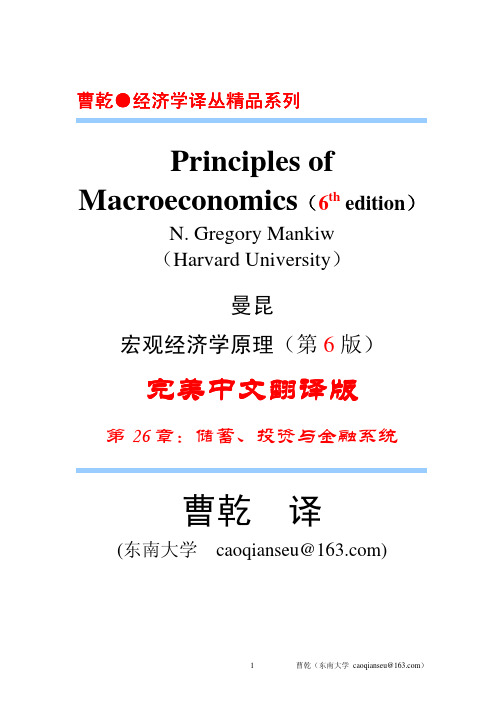
2
曹乾(东南大学 caoqianseu@)
26.1.1 金融市场
金融市场(financial markets)是一类金融机构,通过这些机构,存款者可以直接地将
yield)。股息率是股息占股票价格的百分比。
●市盈率(价格与盈余的比率)。公司的盈余或会计利润,是公司从销售产品中得到的 收入减去生产成本(由会计人员记录)。每股盈余(earnings per share)是公司的总盈余除以
.... 流通股总股数。市盈率(价格与盈余之比,price-earnings ratio),通常简写为 P/E,是公司每
●债券的期限 债券的期限(term)是指债券自发行日至到期日的时间跨度。有些债券的期限较短,比
.. 如几个月;有些债券的期限很长,比如三十年。(英国政府曾经发行过一种称为永久债
... (perpetuity)的债券,该债券永远都不会到期,政府永远向持有者支付利息,但不会归还 本金。)债券的票面利率部分取决于它的期限。长期债券的风险比短期债券的大,因为长期 债券的持有者必须等待更长的时间才能拿到本金。如果长期债券的持有者急需用钱,但债券 还未到期,那么他只有将债券卖给别人,也许会降价出售。为了补偿这样的风险,长期债券 支付的利率通常比短期债券高。
在公司发行股票将股份卖给公众之后,股票持有者在股票交易所买卖股份。在这些交 易中,当股票换手时,发行股票的公司得不到钱。在美国的经济中,最重要的股票交易所是 纽约股票交易所、美国股票交易所和纳斯达克 NASDAQ(NASDAQ 是“全美证券商协会自 动报价系统”英文首字母缩写)。世界上大多数国家都有自己的股票交易所,本国的股票在 这些交易所中进行交易。
论经济学通识课程面向真实世界的重要性——以微观经济学原理课程为例
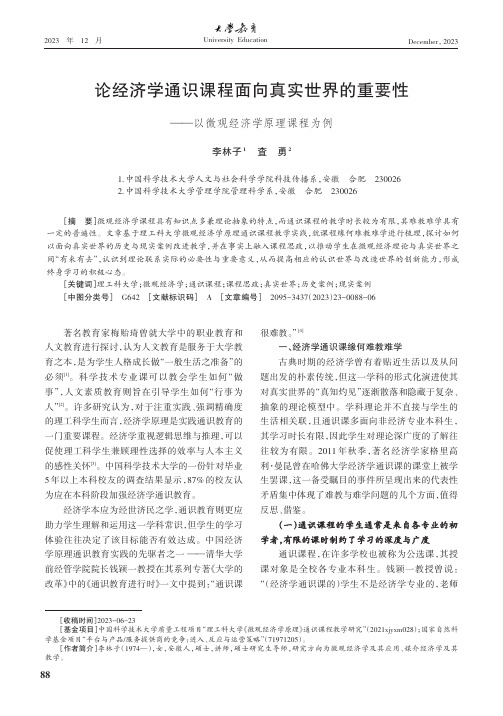
[收稿时间]2023-06-23[基金项目]中国科学技术大学质量工程项目“理工科大学《微观经济学原理》通识课程教学研究”(2021xjyxm028);国家自然科学基金项目“平台与产品/服务提供商的竞争:进入、反应与运营策略”(71971205)。
[作者简介]李林子(1974—),女,安徽人,硕士,讲师,硕士研究生导师,研究方向为微观经济学及其应用、媒介经济学及其教学。
[摘要]微观经济学课程具有知识点多兼理论抽象的特点,而通识课程的教学时长较为有限,其难教难学具有一定的普遍性。
文章基于理工科大学微观经济学原理通识课程教学实践,就课程缘何难教难学进行梳理,探讨如何以面向真实世界的历史与现实案例改进教学,并在事实上融入课程思政,以推动学生在微观经济理论与真实世界之间“有来有去”,认识到理论联系实际的必要性与重要意义,从而提高相应的认识世界与改造世界的创新能力,形成终身学习的积极心态。
[关键词]理工科大学;微观经济学;通识课程;课程思政;真实世界;历史案例;现实案例[中图分类号]G642[文献标识码]A [文章编号]2095-3437(2023)23-0088-06112023年12University Education著名教育家梅贻琦曾就大学中的职业教育和人文教育进行探讨,认为人文教育是服务于大学教育之本,是为学生人格成长做“一般生活之准备”的必须[1]。
科学技术专业课可以教会学生如何“做事”,人文素质教育则旨在引导学生如何“行事为人”[2]。
许多研究认为,对于注重实践、强调精确度的理工科学生而言,经济学原理是实践通识教育的一门重要课程。
经济学重视逻辑思维与推理,可以促使理工科学生兼顾理性选择的效率与人本主义的感性关怀[3]。
中国科学技术大学的一份针对毕业5年以上本科校友的调查结果显示,87%的校友认为应在本科阶段加强经济学通识教育。
经济学本应为经世济民之学,通识教育则更应助力学生理解和运用这一学科常识,但学生的学习体验往往决定了该目标能否有效达成。
- 1、下载文档前请自行甄别文档内容的完整性,平台不提供额外的编辑、内容补充、找答案等附加服务。
- 2、"仅部分预览"的文档,不可在线预览部分如存在完整性等问题,可反馈申请退款(可完整预览的文档不适用该条件!)。
- 3、如文档侵犯您的权益,请联系客服反馈,我们会尽快为您处理(人工客服工作时间:9:00-18:30)。
Y – C – G =I
等式左边就是经济中支付消费和政府购买之后 的总收入,称为国民储蓄,或简称储蓄(S) The left side of the equation is the total income in the economy after paying for consumption and government purchases and is called national saving, or just saving (S).
22
税收与储蓄 Taxes and Saving
减税增加了家庭在给定利率下进行储蓄的激励 A tax decrease increases the incentive for households to save at any given interest rate.
3
储 蓄 Saving
假定有一个封闭经济——一个不从事 国际贸易的经济。 Assume a closed economy – one that does not engage in international trade:
Y=C+I+G
4
储 蓄 Saving
现在,从等式两边同时减去C和G Now, subtract C and G from both sides of the equation:
19
可贷资金市场 Market for Loanable Funds...
供给Supply
利率 Interest Rate
5%
需求Demand 可贷资金(十亿美元) Loanable Funds (in 20 billions of dollars)
0
$1,200
影响储蓄与投资的政府政策 Government Policies That Affect Saving and Investment 税收与储蓄 Taxe 政府预算赤字 Government budget deficits
15
可贷资金市场的供给:储蓄 Supply of Loanable Funds: Saving
由于高利率使储蓄更有吸引力(当期消费更缺 乏吸引力),所以,随着利率的上升,可贷资 金的供给量增加。 Because a high interest rate makes saving more attractive, the quantity of loanable funds supplied rises as the interest rate rises. 可贷资金的供给曲线向右上方倾斜。 The supply curve for loanable funds slopes upward.
私人储蓄Y-C-T:税收T,利率r 公共储蓄T-G:政府支出G,税收T
14
可贷资金市场的供给:储蓄 Supply of Loanable Funds: Saving
利率是借(贷)款的价格。 The interest rate is the price of the loan. 它代表借入者为贷款支付和借出者从储蓄中得 到的金额。 It represents the amount that borrowers pay for loans and the amount that lenders receive on their saving. 可贷资金市场上的利率是实际利率。 The interest rate in the market for loanable funds is the real interest rate.
17
可贷资金市场的需求:投资 Demand for Loanable Funds: Investment
由于高利率使得借款更为昂贵,所以,随着利 率的上升,可贷资金的需求量减少。 Because a high interest rate makes borrowing more expensive, the quantity of loanable funds demanded falls as the interest rate rises. 可贷资金的需求曲线向右下方倾斜。 The demand curve for loanable funds slopes downward.
7
公共储蓄 Public Saving
公共储蓄是政府支付了其支出之后的税 收收入。 Public saving is the amount of tax revenue that the government has left after paying for its spending.
Public saving ≡ (T – G)
第二十六章 储蓄、投资和金融体系 Saving, Investment, and the Financial System
储蓄与投资 Saving and Investment
储蓄与投资是GDP与生活水平长期增长的重要 决定因素。 Saving and Investment are important determinants of long-run growth in GDP and living standards. 宏观经济学家需要了解什么决定储蓄与投资, 特别是金融市场如何运作以及各类事件和政策 如何影响储蓄与投资。 Macroeconomists need to understand what determines saving and investment, especially how financial markets work and how various events and policies affect them.
13
可贷资金市场的供给:储蓄 Supply of Loanable Funds: Saving
可贷资金的供给(S)来自于那些有多余收入 需要储蓄和贷出的人。 The supply of loanable funds comes from people who have extra income they want to save and lend out. 影响因素(收入Y给定)
12
可贷资金市场 The Market for Loanable Funds
可贷资金指人们用来储蓄并借出、而不 是用于自己消费的所有收入 Loanable funds refers to all income that people have chosen to save and lend out, rather than use for their own consumption.
11
可贷资金市场 The Market for Loanable Funds
金融市场协调经济中可贷资金市场上的储 蓄和投资。 Financial markets coordinate the economy’s saving and investment in the market for loanable funds.
私人储蓄是支付了税收和消费之后余下 的家庭收入。 Private saving is the amount of income that households have left after paying their taxes and paying for their consumption.
Private saving ≡ (Y – T – C)
S≡Y–C–G
5
储 蓄 Saving
国民储蓄(或储蓄)等于: National saving, or saving, is equal to:
S≡Y–C–G S ≡ (Y – T – C) + (T – G)
特例:没有政府,G = T = 0,S ≡ Y - C
6
私人储蓄 Private Saving
9
储蓄与投资 Saving and Investment
以S代替Y-C-G,等式可以写成 Substituting S for Y-C-G, the equation can be written as:
S=I
对整个经济而言,储蓄必然等于投资。 For the economy as a whole, saving must be equal to investment.
通过假设经济当中只有单一的金融市场,我 们集中精力来解释金融市场如何协调整体经济 的储蓄与投资。 Assuming that the economy has a single financial market, we focus on explaining how financial markets coordinate the economy’s saving and investment as a whole.
2
储 蓄 Saving
回忆GDP既是经济中的总收入,也是花在经 济中产品和服务的总产出上的总支出。 Recall that GDP is both total income in an economy and total expenditure on the economy’s output of goods and services: Y = C + I + G + NX 经济决定其既定收入(Y)在不同用途(包括 投资)的支出上的选择。 不过,经济中收入获得者(家庭)通常不直 接进行投资;而是作为资本的借出方——储蓄 者。
18
可贷资金市场上的供给与需求 Supply and Demand for Loanable Funds
金融市场的运作和经济中的其他市场 非常相似。 Financial markets work much like other markets in the economy.
可贷资金的供求均衡决定了实际利率。 The equilibrium of the supply and demand for loanable funds determines the real interest rate.
